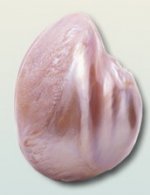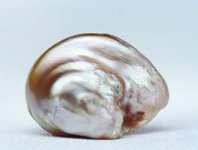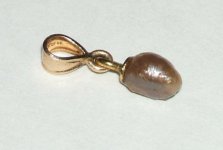mausketeer
New Member
I'm sure this is on the forum SOMEWHERE but when I searched for it, didn't find anything...... sorry if this is a duplication! Was looking up "American Freshwater pearls" and came across this: it grew around a SNAIL! How awesome is THAT? LOVE it! Story and links below (with some interesting pearl info on the website as well......)
"Origin of name -
The 90.35-carat, natural, freshwater pearl, considered as the largest documented baroque pearl in a snail-like formation, is believed to have originated inside a freshwater mussel species in the Tennessee river, which was invaded by a snail parasite. The reaction of the mussel was to inactivate the parasitic snail and render it harmless, by laying down layer after layer of nacre in the form of alternating layers of conchiolin and aragonite around the snail, a natural response of the freshwater mussel for its survival. It has been estimated that the freshwater mollusk lived for 50-70 years even after invasion by the parasite, and thus the snail-like pearl formation would have grown inside the mussel for that period of time. Thus the name "survival" given to this pearl, is undoubtedly the most appropriate name that could have been given to a pearl of this caliber and rarity, which clearly reflects its genesis inside the mussel, whose "survival" was ensured by its formation.
Characteristics of the pearl
The "Survival Pearl" falls under the category of baroque pearls, having an irregular shape, but yet has a recognizable shape in the form of a snail, believed to have been formed naturally around a snail parasite that invaded the mussel, which acted as the nucleus of the developing pearl. The pearl has dimensions of 30.5 x 25.2 x 17.15 mm and a weight of 18.07 grams equivalent to 90.35 carats or 361.40 grains. The color of the pearl is a beautiful lavender-pink, a color most sought-after in pearls, and whose occurrence is less than 5% of all natural freshwater pearls. The extraordinary combination of size, unusual baroque shape, and rare lavender-pink color, makes the "Survival Pearl" one of the rarest and most famous pearls in the world."
http://www.internetstones.com/survi...hwater-baroque-pearl-north-america-japan.html


"Origin of name -
The 90.35-carat, natural, freshwater pearl, considered as the largest documented baroque pearl in a snail-like formation, is believed to have originated inside a freshwater mussel species in the Tennessee river, which was invaded by a snail parasite. The reaction of the mussel was to inactivate the parasitic snail and render it harmless, by laying down layer after layer of nacre in the form of alternating layers of conchiolin and aragonite around the snail, a natural response of the freshwater mussel for its survival. It has been estimated that the freshwater mollusk lived for 50-70 years even after invasion by the parasite, and thus the snail-like pearl formation would have grown inside the mussel for that period of time. Thus the name "survival" given to this pearl, is undoubtedly the most appropriate name that could have been given to a pearl of this caliber and rarity, which clearly reflects its genesis inside the mussel, whose "survival" was ensured by its formation.
Characteristics of the pearl
The "Survival Pearl" falls under the category of baroque pearls, having an irregular shape, but yet has a recognizable shape in the form of a snail, believed to have been formed naturally around a snail parasite that invaded the mussel, which acted as the nucleus of the developing pearl. The pearl has dimensions of 30.5 x 25.2 x 17.15 mm and a weight of 18.07 grams equivalent to 90.35 carats or 361.40 grains. The color of the pearl is a beautiful lavender-pink, a color most sought-after in pearls, and whose occurrence is less than 5% of all natural freshwater pearls. The extraordinary combination of size, unusual baroque shape, and rare lavender-pink color, makes the "Survival Pearl" one of the rarest and most famous pearls in the world."
http://www.internetstones.com/survi...hwater-baroque-pearl-north-america-japan.html



